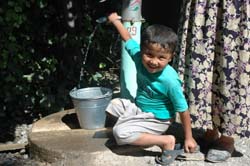World Water Day 2009
| |
 |
| |
An Uzbek boy fills up on fresh water from the Kyrgyz well. Read the full story.
Source: Mahabat Alymkulova |
March 22 is World Water Day, which aims to raise awareness around the world about the importance of access to clean, safe water.
Safe drinking water is becoming ever more precious and hard to find. More than 1 billion people in the developing world do not have access to clean water and in many cases rely on water from polluted rivers and lakes and unsafe wells or piped water supplies. The consequences are catastrophic.
About 1.7 million children under age 5 died last year from diarrheal diseases caused by unsafe water and sanitation in developing countries, and millions more were put at significant risk of exposure to water-borne infections such as cholera, typhoid fever, and dysentery. Contaminated drinking water is also a threat to people living with HIV/AIDS.
The recent cholera outbreak in Zimbabwe is a stark example of the need for clean, safe drinking water. More than 91,000 people have contracted cholera, and more than 4,000 have died from this easily preventable and treatable intestinal infection. The disease is rampant because drinking water has been contaminated and people lack the chemicals to purify it.
Those without safe water and sanitation are likely to be poor, hungry, and malnourished. The increasing scarcity of safe water, combined with rapid worldwide population growth and environmental degradation, is also leading to biodiversity loss and agricultural failure.
Improving access to safe drinking water is an important component of USAID health and emergency response programs. Household water treatment and safe storage reduces water-borne disease, empowers families and communities, and improves productivity. These measures complement community and municipal water supply infrastructure programs by providing immediate access to safe water while construction is planned or implemented. Several options for ensuring safe drinking water in the household or at the point-of-use are available, including chlorination, filtration, solar disinfection, and combined methods such as Procter and Gamble’s PuR sachet, which disinfects and removes large particles from water. These inexpensive and easy-to-use solutions can be deployed and adopted rapidly.
There are many innovative examples of how USAID works to increase access to safe water and improve water quality in households.
USAID Success Stories
Additional Information
- United Nations World Water Day 2009 Web site
The UN marks World Water Day on March 22, highlighting the world’s 263 transboundary lake and river basins that cross borders and link us together.
-
Best Practices in Social Marketing Safe Water Solution for Household Water Treatment [PDF, 1.1MB]
This publication examines lessons and best practices from Population Services International (PSI) field programs in 18 countries over the past eight years. This paper synthesizes lessons learned, best practices, successes, and challenges of social marketing point-of-use safe water solutions and discusses how these lessons may be applied to planning safe water treatment programs around the globe to reduce diarrheal disease in vulnerable populations.
- POUZN to Reach Over One Million with Point-of-Use Water Disinfection in India
The AED-managed USAID Point-of-Use Water Disinfection and Zinc Treatment (POUZN) project expects to introduce 1.1 million urban and rural poor residents in Uttar Pradesh to household water treatment products and systems through a phase two expansion that commenced recently.
|


